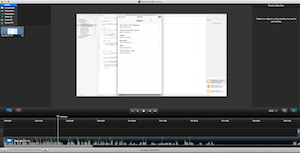 This time, in Episode 26, I interview Rondale Williams. Rondale is a freelance mobile developer new to the development space. During the course of our interview, Rondale talks about what it is like to be self-taught, why he started to go back to college for CS, and what his advice would be to other people just starting out. We also talk about RxJava, Android Emulators, the Android vs iOS development ecosystems, and whether or not he’s found the community to be friendly.
This time, in Episode 26, I interview Rondale Williams. Rondale is a freelance mobile developer new to the development space. During the course of our interview, Rondale talks about what it is like to be self-taught, why he started to go back to college for CS, and what his advice would be to other people just starting out. We also talk about RxJava, Android Emulators, the Android vs iOS development ecosystems, and whether or not he’s found the community to be friendly.
Links Mentioned in this Show:
Rondale’s Blog
Rondale’s Twitter
Rondale’s LinkedIn
RxJava
Genymotion
Lynda.com
Pluralsight
The New Boston (Bucky’s World)
Udemy
Udacity
Meetup
RemoteCoder.io
You can also subscribe to the podcast at any of these places:


Thanks to all the people who listen, and a special thanks to those who have rated me. I really appreciate it.
The episodes have been archived. Click Here to see the archive page.

 Episode 24 was planned to be timely, but it ended up being super timely. Originally, I wanted to have Wolfgang Goerlich come on and talk about application security after the iCloud photo leaks. But, between the time that we recorded the interview and the time I’m releasing this episode, the Shellshock bug/vulnerability came to light as well. Listen, folks, writing secure software is hard! Wolfgang talks about the average day in the life of the good guys, what mindset makes a good security expert, how developers can write more secure code, why the Internet of Things might be a security nightmare, and why you shouldn’t “poke the bear”.
Episode 24 was planned to be timely, but it ended up being super timely. Originally, I wanted to have Wolfgang Goerlich come on and talk about application security after the iCloud photo leaks. But, between the time that we recorded the interview and the time I’m releasing this episode, the Shellshock bug/vulnerability came to light as well. Listen, folks, writing secure software is hard! Wolfgang talks about the average day in the life of the good guys, what mindset makes a good security expert, how developers can write more secure code, why the Internet of Things might be a security nightmare, and why you shouldn’t “poke the bear”. So, ever since I did my
So, ever since I did my  This time, in Episode 23, I recap the September 2014 Apple Launch Event. During this event, Apple launched iPhone 6 and 6 Plus, along with Apple Pay and Apple Watch. I wasn’t really enthusiastic for this event going in because I don’t like big phones, I couldn’t care less about NFC payments, and I’m not excited about wearables. However, by the end of the presentation, I was excited for 2/4 of the products. Either I’m a sucker for marketing, or some of this stuff might actually be pretty good. Listen and find out which it is.
This time, in Episode 23, I recap the September 2014 Apple Launch Event. During this event, Apple launched iPhone 6 and 6 Plus, along with Apple Pay and Apple Watch. I wasn’t really enthusiastic for this event going in because I don’t like big phones, I couldn’t care less about NFC payments, and I’m not excited about wearables. However, by the end of the presentation, I was excited for 2/4 of the products. Either I’m a sucker for marketing, or some of this stuff might actually be pretty good. Listen and find out which it is.